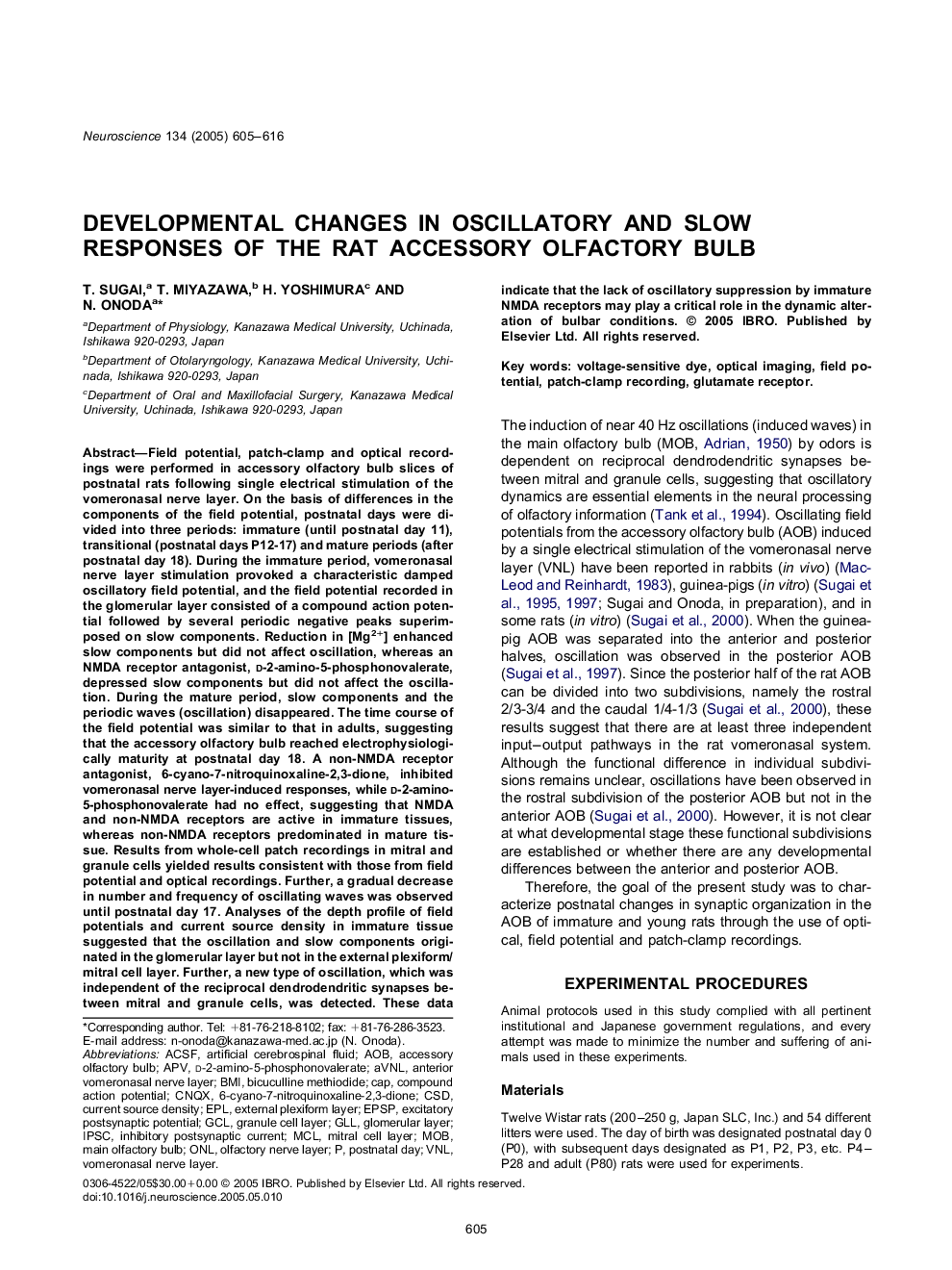| کد مقاله | کد نشریه | سال انتشار | مقاله انگلیسی | نسخه تمام متن |
|---|---|---|---|---|
| 9425741 | 1295889 | 2005 | 12 صفحه PDF | دانلود رایگان |
عنوان انگلیسی مقاله ISI
Developmental changes in oscillatory and slow responses of the rat accessory olfactory bulb
دانلود مقاله + سفارش ترجمه
دانلود مقاله ISI انگلیسی
رایگان برای ایرانیان
کلمات کلیدی
vomeronasal nerve layerAOBMCLVNLMOBaCSFGLLONLGCLIPSCEPLAPVCSD6-Cyano-7-nitroquinoxaline-2,3-dione - 6-Cyano-7-nitroquinoxaline-2،3-dioned-2-amino-5-phosphonovalerate - d-2-amino-5-fosfonovalerateEPSP - epspicurrent source density - تراکم منبع فعلیOptical imaging - تصویربرداری نوریinhibitory postsynaptic current - جریان پستانیپتیک مهارکنندهvoltage-sensitive dye - رنگ حساس به ولتاژpostnatal day - روز پس از زایمانCNQX - سیانکیوایکسBMI - شاخص توده بدنیPatch-clamp recording - ضبط پچ-گیرهmain olfactory bulb - لامپ عصبانی اصلیaccessory olfactory bulb - لامپ متلاشی کننده لوازم جانبیexternal plexiform layer - لایه بیرونی خارجیgranule cell layer - لایه سلول گرانولmitral cell layer - لایه سلولی میترالolfactory nerve layer - لایه عصبی بویاییglomerular layer - لنف گلومرولیartificial cerebrospinal fluid - مایع مغزی نخاعی مصنوعیbicuculline methiodide - متیکویدید bicucullineCompound Action Potential - پتانسیل اقدام مشترکField potential - پتانسیل میدانexcitatory postsynaptic potential - پتانسیل پست سیناپتی هیجان انگیزCaP - کلاه لبه دارGlutamate receptor - گیرنده گلومات
موضوعات مرتبط
علوم زیستی و بیوفناوری
علم عصب شناسی
علوم اعصاب (عمومی)
پیش نمایش صفحه اول مقاله

چکیده انگلیسی
Field potential, patch-clamp and optical recordings were performed in accessory olfactory bulb slices of postnatal rats following single electrical stimulation of the vomeronasal nerve layer. On the basis of differences in the components of the field potential, postnatal days were divided into three periods: immature (until postnatal day 11), transitional (postnatal days P12-17) and mature periods (after postnatal day 18). During the immature period, vomeronasal nerve layer stimulation provoked a characteristic damped oscillatory field potential, and the field potential recorded in the glomerular layer consisted of a compound action potential followed by several periodic negative peaks superimposed on slow components. Reduction in [Mg2+] enhanced slow components but did not affect oscillation, whereas an NMDA receptor antagonist, d-2-amino-5-phosphonovalerate, depressed slow components but did not affect the oscillation. During the mature period, slow components and the periodic waves (oscillation) disappeared. The time course of the field potential was similar to that in adults, suggesting that the accessory olfactory bulb reached electrophysiologically maturity at postnatal day 18. A non-NMDA receptor antagonist, 6-cyano-7-nitroquinoxaline-2,3-dione, inhibited vomeronasal nerve layer-induced responses, while d-2-amino-5-phosphonovalerate had no effect, suggesting that NMDA and non-NMDA receptors are active in immature tissues, whereas non-NMDA receptors predominated in mature tissue. Results from whole-cell patch recordings in mitral and granule cells yielded results consistent with those from field potential and optical recordings. Further, a gradual decrease in number and frequency of oscillating waves was observed until postnatal day 17. Analyses of the depth profile of field potentials and current source density in immature tissue suggested that the oscillation and slow components originated in the glomerular layer but not in the external plexiform/mitral cell layer. Further, a new type of oscillation, which was independent of the reciprocal dendrodendritic synapses between mitral and granule cells, was detected. These data indicate that the lack of oscillatory suppression by immature NMDA receptors may play a critical role in the dynamic alteration of bulbar conditions.
ناشر
Database: Elsevier - ScienceDirect (ساینس دایرکت)
Journal: Neuroscience - Volume 134, Issue 2, 2005, Pages 605-616
Journal: Neuroscience - Volume 134, Issue 2, 2005, Pages 605-616
نویسندگان
T. Sugai, T. Miyazawa, H. Yoshimura, N. Onoda,